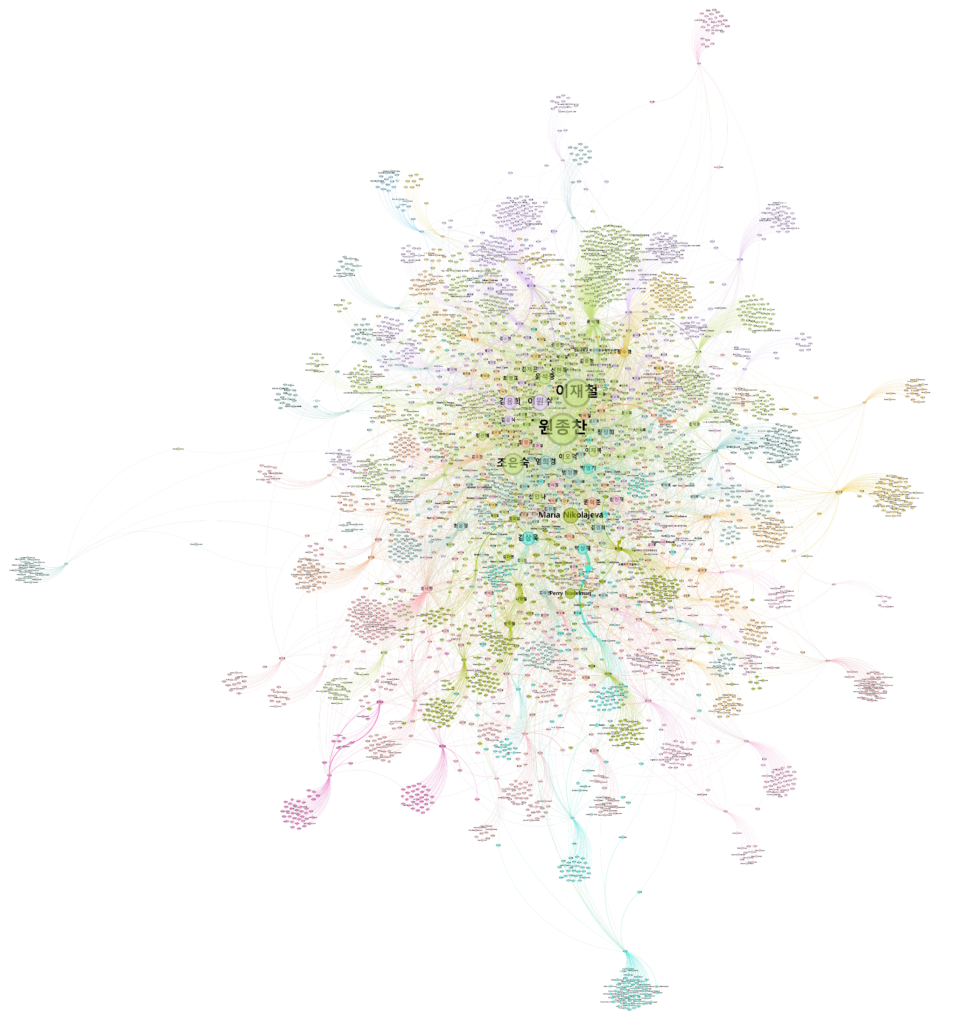아동문학 연구의 지적 구조 분석(2010~2021년) -『아동청소년문학연구』와 『한국아동문학연구』의 저자 동시 인용망 분석- = Analysis of the Intellectual Structure of Children’s Literature Studies (2010–2021) -Co–citation Network Analysis from Studies of Literature for Children and Young Adult & Korea Children’s Literature
https://www.riss.kr/link?id=A108915732
https://github.com/soohwankang/cna_childrens_literature_studies
본 논문은 현대 아동문학 연구계의 지적 구조를 분석하기 위해 저자 동시 인용망 분석을 시도한다. 분석 데이터로는 2010~2021년 사이 아동문학 연구 학술지 『아동청소년문학연구』와 『한국아동문학연구』에 게재된 423편의 논문에 대한 인용 정보를 활용했다. 구체적으로는 연결망을 그래프로 시각화하고, 해당 연결망의 내향 연결 정도 중심성, 근접 중심성, 매개 중심성 수치에 기반을 두어 도출한 결과를 분석 · 해석하고자 했다.
그래프에서는 중심부에 근대 시기의 아동문학을 둘러싼 연구/저자가 주로 모여 있고, 그 외곽으로는 한국 현대 아동문학, 교육학, 아동학, 문화연구 등의 분야가, 그리고 가장 외곽으로는 해외 아동문학 연구 그룹이 포진해 있음을 확인할 수 있었다. 해외아동문학 연구 가운데서는 중국과 일본과 같은 (특히 근대 시기의) 동아시아 아동문학연구가 여타의 그룹에 비해 중심에 가깝다는 점에서 그 영향력을 확인할 수 있다.
또한 각각의 중심성 수치 분석을 통해서는, 근대 아동문학의 형성, 개념 · 용어, 아동문학사 등의 기초 연구의 영향력이 높다는 점, 해외 이론으로 ‘아동’ ‘무의식’ ‘환상성’에 관한 이론의 영향력이 높았다는 점, ‘근대’ ‘아동’ ‘동심주의’ ‘기원’과 같은 키워드를 주제로 삼는 연구들이 흐름을 주도했다는 점, 비교적 소수의 저자가 여러 아동문학 세부연구 분야들을 연결 · 매개하고 있음이 목격된다.
This study attempts a co-citation network analysis to analyze the intellectual structure of contemporary children’s literature studies. The analysis data used citation information from 423 papers published in children’s literature research journals, Studies of Literature for Children and Young Adult and Korea Children’s Literature, between 2010 and 2021. Specifically, the study aimed to visualize the network as a graph and analyze and interpret the results derived based on the in-degree centrality, closeness centrality, and betweenness centrality of the said network.
The graph showed that research/authors on the modern period children’s literature are mainly clustered at the center. Surrounding the periphery are fields such as contemporary Korean children’s literature, pedagogy, child studies, and cultural studies, and at the outermost edges, there are foreign children’s literature studies groups. Among foreign children’s literature studies, research on East Asian children’s literature, especially from the modern era in countries like China and Japan, appeared to be more central compared to other groups, indicating its influence.
Additionally, from the centrality measures analysis, it was observed that foundational studies on the formation, concepts, terms, and history of modern children’s literature hold significant influence. Foreign theories on ‘child’, ‘unconscious’, and ‘fantasy’ have a strong impact. Studies focusing on keywords like ‘modern’, ‘child’, ‘children’s innocence’, and ‘origin’ have been leading the trend. It was also observed that a relatively small number of authors connect and mediate various topics of children’s literature research.

